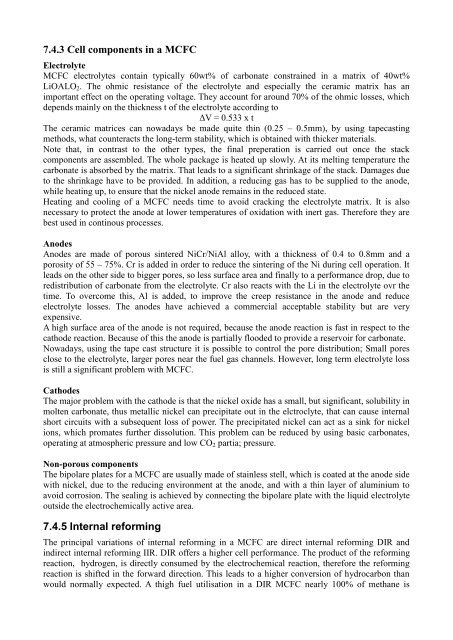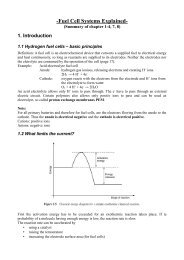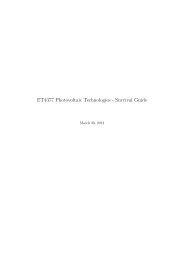Fuel Cell Systems Explained - from and for SET students
Fuel Cell Systems Explained - from and for SET students
Fuel Cell Systems Explained - from and for SET students
Create successful ePaper yourself
Turn your PDF publications into a flip-book with our unique Google optimized e-Paper software.
7.4.3 <strong>Cell</strong> components in a MCFCElectrolyteMCFC electrolytes contain typically 60wt% of carbonate constrained in a matrix of 40wt%LiOALO 2 . The ohmic resistance of the electrolyte <strong>and</strong> especially the ceramic matrix has animportant effect on the operating voltage. They account <strong>for</strong> around 70% of the ohmic losses, whichdepends mainly on the thickness t of the electrolyte according toΔV = 0.533 x tThe ceramic matrices can nowadays be made quite thin (0.25 – 0.5mm), by using tapecastingmethods, what counteracts the long-term stability, which is obtained with thicker materials.Note that, in contrast to the other types, the final preperation is carried out once the stackcomponents are assembled. The whole package is heated up slowly. At its melting temperature thecarbonate is absorbed by the matrix. That leads to a significant shrinkage of the stack. Damages dueto the shrinkage have to be provided. In addition, a reducing gas has to be supplied to the anode,while heating up, to ensure that the nickel anode remains in the reduced state.Heating <strong>and</strong> cooling of a MCFC needs time to avoid cracking the electrolyte matrix. It is alsonecessary to protect the anode at lower temperatures of oxidation with inert gas. There<strong>for</strong>e they arebest used in continous processes.AnodesAnodes are made of porous sintered NiCr/NiAl alloy, with a thickness of 0.4 to 0.8mm <strong>and</strong> aporosity of 55 – 75%. Cr is added in order to reduce the sintering of the Ni during cell operation. Itleads on the other side to bigger pores, so less surface area <strong>and</strong> finally to a per<strong>for</strong>mance drop, due toredistribution of carbonate <strong>from</strong> the electrolyte. Cr also reacts with the Li in the electrolyte ovr thetime. To overcome this, Al is added, to improve the creep resistance in the anode <strong>and</strong> reduceelectrolyte losses. The anodes have achieved a commercial acceptable stability but are veryexpensive.A high surface area of the anode is not required, because the anode reaction is fast in respect to thecathode reaction. Because of this the anode is partially flooded to provide a reservoir <strong>for</strong> carbonate.Nowadays, using the tape cast structure it is possible to control the pore distribution; Small poresclose to the electrolyte, larger pores near the fuel gas channels. However, long term electrolyte lossis still a significant problem with MCFC.CathodesThe major problem with the cathode is that the nickel oxide has a small, but significant, solubility inmolten carbonate, thus metallic nickel can precipitate out in the elctroclyte, that can cause internalshort circuits with a subsequent loss of power. The precipitated nickel can act as a sink <strong>for</strong> nickelions, which promates further dissolution. This problem can be reduced by using basic carbonates,operating at atmospheric pressure <strong>and</strong> low CO 2 partia; pressure.Non-porous componentsThe bipolare plates <strong>for</strong> a MCFC are usually made of stainless stell, which is coated at the anode sidewith nickel, due to the reducing environment at the anode, <strong>and</strong> with a thin layer of aluminium toavoid corrosion. The sealing is achieved by connecting the bipolare plate with the liquid electrolyteoutside the electrochemically active area.7.4.5 Internal re<strong>for</strong>mingThe principal variations of internal re<strong>for</strong>ming in a MCFC are direct internal re<strong>for</strong>ming DIR <strong>and</strong>indirect internal re<strong>for</strong>ming IIR. DIR offers a higher cell per<strong>for</strong>mance. The product of the re<strong>for</strong>mingreaction, hydrogen, is directly consumed by the electrochemical reaction, there<strong>for</strong>e the re<strong>for</strong>mingreaction is shifted in the <strong>for</strong>ward direction. This leads to a higher conversion of hydrocarbon thanwould normally expected. A thigh fuel utilisation in a DIR MCFC nearly 100% of methane is






